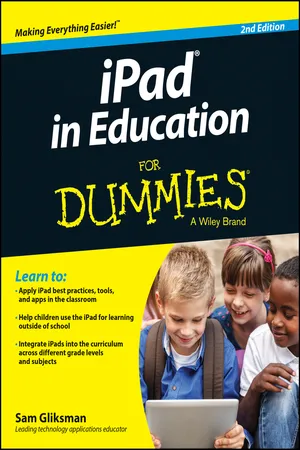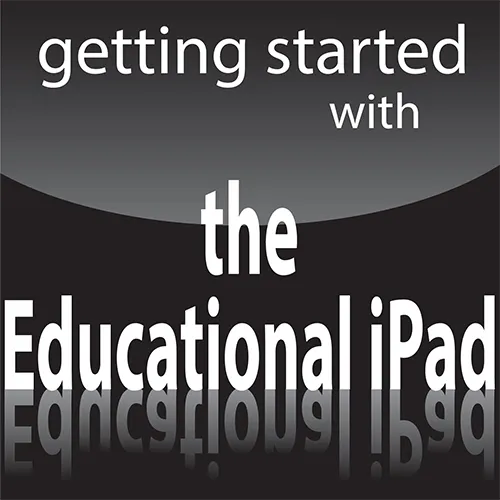
- English
- ePUB (mobile friendly)
- Available on iOS & Android
iPad in Education For Dummies
About This Book
The easy way to effectively implement iPads in the classroom
The iPad is a natural fit for education in the 21 st century, and this hands-on guide shows you just how to implement it in your educational institution. iPad in Education For Dummies serves as a roadmap for the device's successful use as an education tool—from both a personal and institutional perspective. It examines why the iPad is a perfect fit for contemporary educational needs, how to purchase and deploy them within an organization, and outlines best practices, tools, and apps for their educational use across all curricula and grade levels.
A cross between a powerful computer, iPod, game console, and e-reader, the iPad is an ultraportable—and ultra cool—touch device from Apple. In 2013, the iPad was deployed in Chicago Public Schools, LA Unified School district, Oxnard School District in California, and Raleigh County Public Schools in West Virginia, to name a few. In this new edition of iPad in Education For Dummies, you'll find the latest coverage of interactive media and augmented reality apps, creating and publishing class books and textbooks, moving from lectures to interactive classroom presentations, setting up digital student profiles, and much more.
- Includes up-to-date coverage of Apple's iPad hardware and iOS software
- Covers managing classroom workflow challenges, including how to distribute, share, collaborate, and collect digital documents
- Written by one of the foremost authorities on iPad deployments in schools
- Provides clear information on what decisions you need to make to deploy and use the iPad effectively in the classroom
If you're a school administrator, teacher, or educational IT specialist who is considering deploying the iPad in the classroom, this handy guide has everything to set you up for success.
Frequently asked questions
Information
Getting Started with the Educational iPad

- Examine the evolving educational needs of students in the 21st century
- Learn the basics about navigating and using an iPad
- Explore options for deployment and management of iPads in schools
- Find out how to make volume purchases of apps and eBooks
Education in the 21st Century



Investigating New Educational Models
Re-evaluating educational objectives in a changing world
- Lacking technology: Students lead technology-filled lives outside of school, yet many of them have only minimal access to personal technology for learning within school itself.
- Using technology for a 20th-century education: Simply adding a dose of technology to the standard educational mix may not be enough if that technology is patched over outdated objectives and pedagogies.
- Replacing rote memorization with real skills: Skills such as critical thinking, communication, and creativity have increasingly greater value than the rote memorization of content. After all, the vast majority of content can be easily accessed within seconds on most mobile devices. We’ve even created a verb to describe it. What do you do when you want to know something? You “google” it!
- Navigating the information jungle: Historically, an important function of education was to provide students with access to textbook content and teacher expertise. Today, content and expertise are abundantly available online. There’s so much information available that new educational priorities are needed to help students navigate the vast volumes of content. Information literacy skills help students access, organize, filter, evaluate, and use the enormous amount of information available online. The core question is morphing from “What do you know?” to “What can you do with what you know?”
- Working in groups (because there’s no I in teamwork): We live in an emerging global society, and the development of collaborative skills — the ability to work effectively in teams — outweighs traditional demands that students sit still, listen, and work only on their own.
- Incorporating multimedia literacy: Text remains an important medium for conveying information, but multimedia is becoming the language of new generations, and its use should be encouraged in schools. Further, we need to discuss and develop standards that assist students in creating media that communicate the intended message effectively.
- Saying goodbye to the 30-pound backpack: At higher grade levels, most courses are still delivered and structured around the use of a single textbook — often one that was printed several years ago. That’s a stark contrast to a world where news and information are always up to date and available from a wide variety of sources and perspectives.
- Reaching beyond the school walls: School is still the central hub for learning, but technology now enables us to be constantly connected. The old model of learning within the physical confines of a classroom or school campus is being completely redefined. In the age of the Internet, learning can occur anywhere and is available on demand.
- Staying flexible is key: Instruction and curriculum need to constantly adapt to new information, technologies, and interests.
- Differentiated instruction and assessment: Some students are great auditory processors. Explain something once to them and they get it. Others need to sit and read. Many students lean to more visual modes of learning. Technology offers options for differentiated instruction and alternative forms of assessment, which free us from a “one size fits all” teaching model. (And in reality, that model never worked anyway!)
- Limiting frontal teaching: New technologies placed in the hands of students empower them to research, explore, and create. Use of technology can and should move us from frontal, content-delivery models of education to more student-centered, discovery-based, and interactive learning practices.
- Knowing that learning never ends: We’re all students who must continually learn and adapt to constant change. School is only part of our educational journey. Instead of focusing on preparation for assessments and certificates, we need to rediscover the joy that’s inherent in the process of learning itself. Our objective should be to develop students who are independent, lifelong learners who can continue to thrive in a society of continual and rapid change.
Implementing iPads for 21st-century learning
- Learning on the go: An iPad weighs less than a pound and a half and is well suited to the goal of “anytime, anywhere” education. You can take it with you wherever you go. Store it easily in a bag or backpack, or just carry it on your person. Plus, the iPad’s battery has up to ten hours of life, so you won’t have to deal with cords and electrical outlets. Charge your iPad overnight, and it will be ready and available all day long.
- Kicking back and relaxing: Use your iPad any way that feels comfo...
Table of contents
- Cover
- Title Page
- Table of Contents
- Introduction
- Part I: Getting Started with the Educational iPad
- Part II: Finding and Using Apps
- Part III: Finding and Organizing Educational Content
- Part IV: Reading, Writing, and ’Rithmetic in the Digital Age
- Part V: Expressing Yourself with Media
- Part VI: The iPad Classroom
- Part VII: The Part of Tens
- Appendix: Modeling the iPad Classroom
- About the Author
- Cheat Sheet
- More Dummies Products
- End User License Agreement
